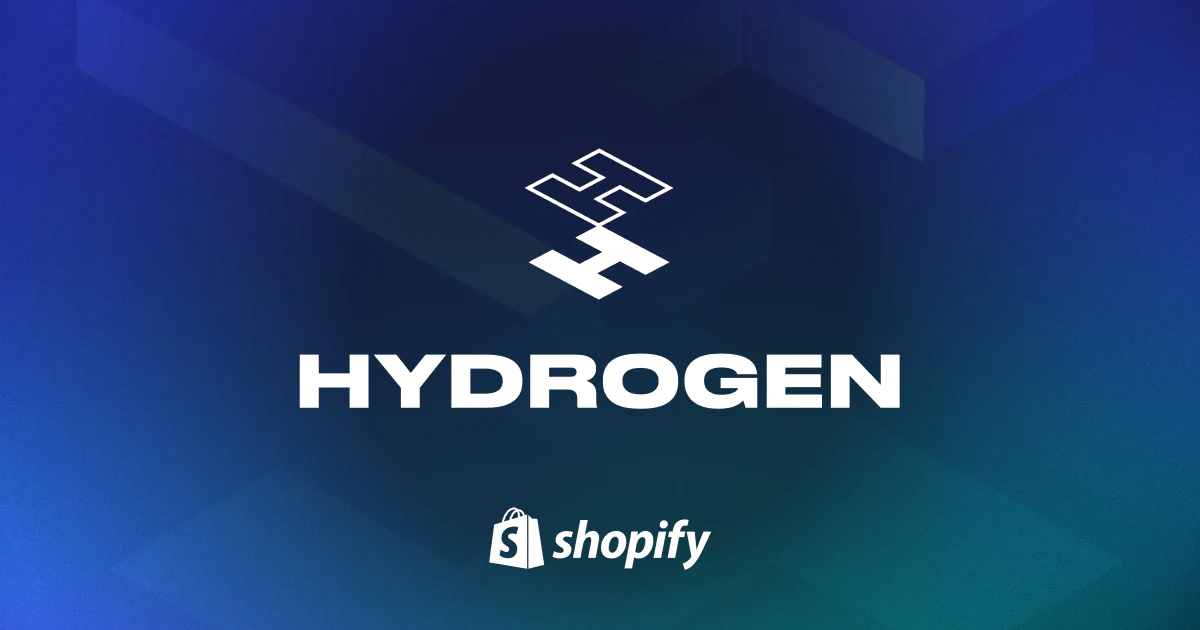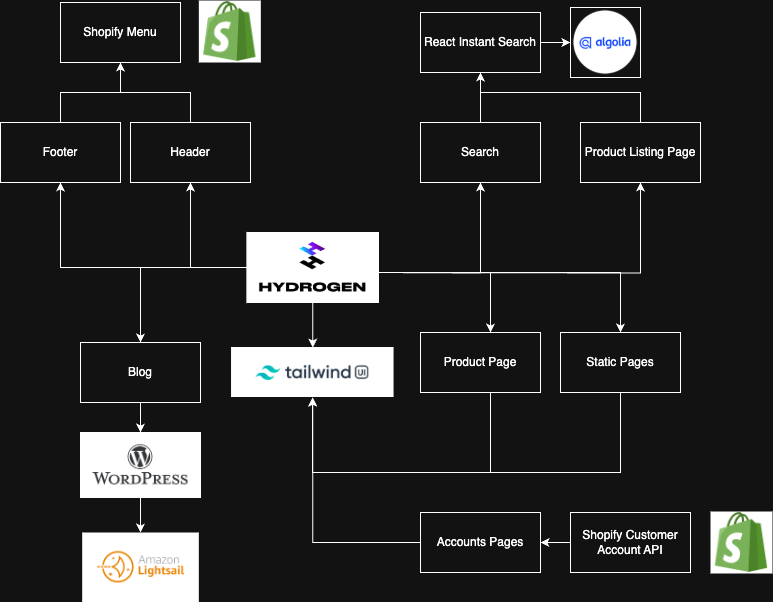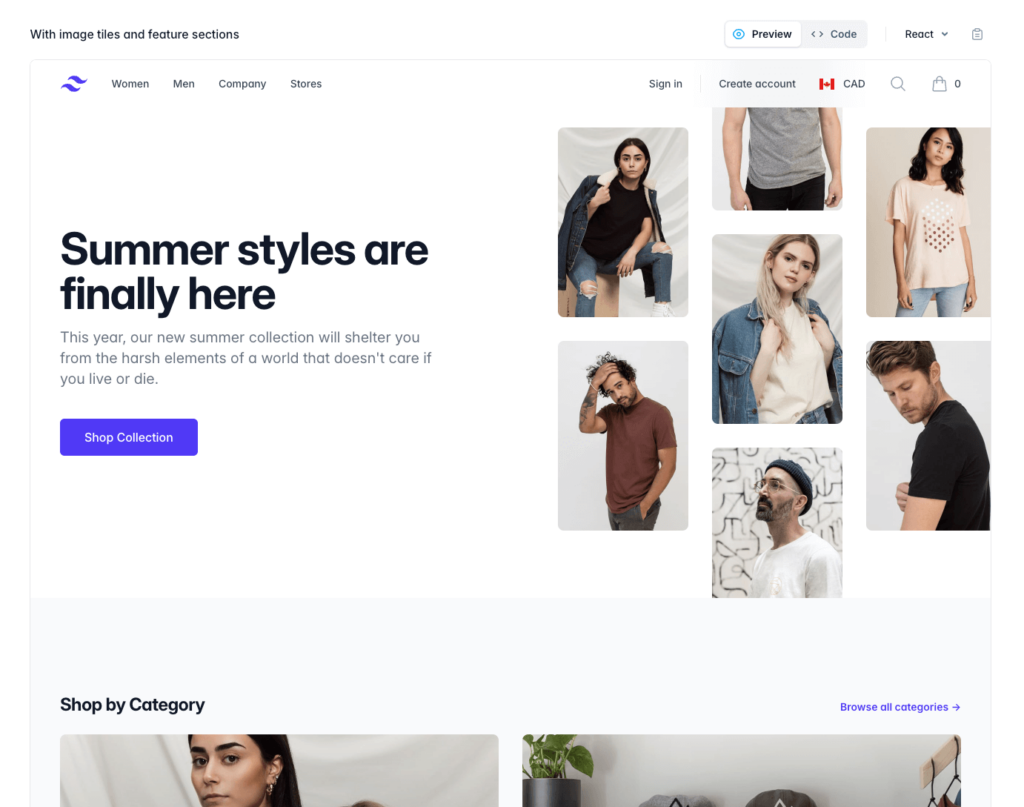Shopify Hydrogen Use Case: Building a Scalable Headless eCommerce Site

In today’s fast-paced ecommerce landscape, flexibility and speed are crucial for delivering the best shopping experience. As developers, we need tools that let us create fast, responsive, and customized online stores without sacrificing scalability. This is where Shopify Hydrogen comes into play.
In this blog post, we’ll explore a Shopify Hydrogen use case to build a scalable headless ecommerce site. We’ll break down each component—header, footer, blog integration, search, product listing pages, and more—showing how Hydrogen integrates seamlessly with other tools and frameworks to create a cohesive shopping platform.
Finally, I’ll also be linking other dedicated blog post on how to implement each respective components. Here’s an overview on how each and every component will play out.

Why Use Shopify Hydrogen?
This eCommerce store example focuses on selling steel products, which often come with unique challenges that a traditional Shopify theme might struggle to handle. There are two primary reasons why I’ve leaned towards Shopify’s Hydrogen; these are the following:
1. Integrated Quotation System
- Many steel products cannot be added directly to the cart due to their custom nature. Instead, buyers often request personalized quotations based on their specifications.
- This setup allows us to build a quotation system alongside the ecommerce store, enabling users to:
- Submit requests for quotes (RFQs) with custom measurements or bulk orders.
- Receive automated or manual quotes generated through backend systems.
2. Flexible Product Configuration
- Roofing materials frequently require a cutting list specifying the exact dimensions for each piece. However, for simplicity and compatibility with Shopify’s backend, these are computed and sold as total linear meters in the ecommerce store.
- Reduce friction to shopping bundled products. In their industry its a common practice that some products are tightly coupled with other products. To give a concrete example, a computed quantity of 100 meters of a roofing metal sheet would normally require a 50 pieces of metal screws.
TailwindUI as the Component Kit
In this Shopify Hydrogen use case, we leverage Tailwind UI as the component kit for building product pages, static content, and dynamic layouts. Tailwind UI is a collection of professionally designed, pre-built components developed by the creators of Tailwind CSS—a popular utility-first CSS framework.

One standout feature of Tailwind UI is its dedicated ecommerce section, which includes pre-built components specifically designed for online stores. These components simplify the development of essential ecommerce features
1. Shopify Menu Integration with Hydrogen
The header and footer are the backbone of any ecommerce site, providing navigation and essential links. In this setup, Shopify Hydrogen integrates with Shopify’s Menu API to dynamically render menu items.
Shopify’s Menu Items is robust as it can be linked to Categories, Products or simply a static link. One of the challenges is to modify Hydrogen’s code to get the featured image and the link of these menu items.
How it Works:
- Review or select a menu design from TailwindUI navigation
- Use Shopify’s GraphQL Storefront API to fetch navigation links.
- Render dynamic menus that automatically update when changes are made in Shopify.
- Plug-in the values
Why This Setup Works:
- Centralized control through Shopify’s backend.
- Seamless updates without requiring frontend changes.
- Lastly, mobile-friendly navigation with dropdowns and sidebars.
2. Shopify Hydrogen with React Instant Search
Product search and filtering can make or break user experience. This setup uses React InstantSearch and Algolia to deliver fast, accurate, and dynamic search results, ensuring customers can quickly locate products based on specifications, dimensions, or categories.
How it Works:
- Install the Algolia Search and Discovery in your Shopify Store
- Select an eCommerce layout from TailwindUI Product Listing Pages
- Lastly, use built-in components from React Instant Search
Why This Setup Works:
- Designed for large and complex product catalogs
- Evidently simplifies technical product discovery
- Built with React and styled using Tailwind UI, the search interface is fully responsive, providing a smooth experience across mobile and desktop devices.
3. Shopify Hydrogen with WordPress
For eCommerce sites that rely on content marketing, having a robust blog component is essential. This setup uses WordPress hosted on Amazon Lightsail to power the blog section. Using a headless CMS approach, the blog content is fetched through WordPress GraphQL endpoint and rendered in Shopify Hydrogen’s React-based frontend.
How it Works:
- Enable GraphQL plugin on WordPress
- Create a new third-party API client in Hydrogen
- Pass the API client to the Remix context
- Finally, query and render the list of entries
Why This Setup Works:
- Blog posts, guides, and FAQs are managed directly in WordPress, taking advantage of its user-friendly editor and SEO plugins like Yoast SEO.
- The WordPress blog is hosted on Amazon Lightsail, a cost-effective and scalable hosting solution that ensures high performance and uptime reliability.
- Moreover, separating the blog from the Shopify backend allows developers to work independently on content and eCommerce features.
Final Thoughts on Shopify Hydrogen Use Case
This Shopify Hydrogen use case demonstrates how a headless eCommerce setup can handle the unique requirements of selling complex product lines—from dynamic search and filtering to custom pricing and quotation systems. By integrating tools like WordPress for blogging, Algolia for search, and Tailwind UI for styling, this approach ensures both flexibility and scalability as the business grows.
The combination of React InstantSearch, Customer Account API for account pages, and custom product configurations simplifies complex workflows, allowing customers to:
- Search for products using specific tags and categories
- Tie up metadata with products for backend order processing
- Receive custom quotes for bundled orders
- Finally, access SEO-optimized blog content for conversion
At this time, the current site is still being built. As a result, this blog post will be continuously updated in the hope of providing deeper insights into the development process and highlighting additional features as they’re implemented.